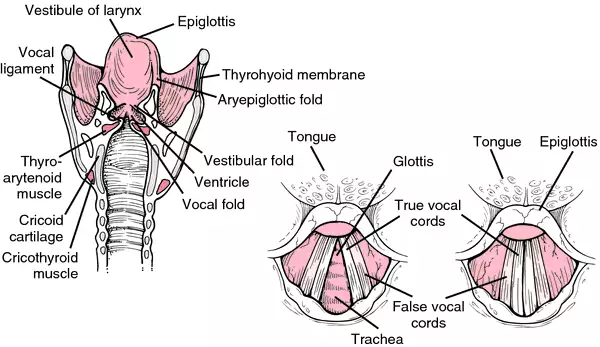Medical term:
Electrolarynx
larynx
[lar´ingks] (Gr.)the muscular and cartilaginous structure, lined with mucous membrane, situated at the top of the trachea and below the root of the tongue and the hyoid bone; it contains the vocal cords and is the source of the sound heard in speech. The larynx is part of the respiratory system; air passes through it traveling from the pharynx to the trachea on its way to the lungs and again returning to the exterior.
The larynx is composed of nine cartilages that are held together by muscles and ligament: the single thyroid, cricoid, and epiglottic cartilages and the paired arytenoid, corniculate, and cuneiform cartilages. (See also color plates.) The largest of these, the thyroid cartilage, forms the Adam's apple, which protrudes in the front of the neck. Two flexible vocal cords reach from the back to the front wall of the larynx and are manipulated by small muscles to produce sound. The epiglottis, a flap or lid at the base of the tongue, closes the larynx as it is lifted up during swallowing and so prevents passage of food or drink into the larynx and trachea.
The larynx is composed of nine cartilages that are held together by muscles and ligament: the single thyroid, cricoid, and epiglottic cartilages and the paired arytenoid, corniculate, and cuneiform cartilages. (See also color plates.) The largest of these, the thyroid cartilage, forms the Adam's apple, which protrudes in the front of the neck. Two flexible vocal cords reach from the back to the front wall of the larynx and are manipulated by small muscles to produce sound. The epiglottis, a flap or lid at the base of the tongue, closes the larynx as it is lifted up during swallowing and so prevents passage of food or drink into the larynx and trachea.

Larynx.
artificial larynx an electromechanical device that enables a person after laryngectomy to produce speech. When the device is placed against the region of the laryngectomy a buzzing sound is made that can be converted into simulated speech by movements of the lips, tongue, and glottis. Called also electrolarynx.
Miller-Keane Encyclopedia and Dictionary of Medicine, Nursing, and Allied Health, Seventh Edition. © 2003 by Saunders, an imprint of Elsevier, Inc. All rights reserved.
electrolarynx
Head & neck surgery A battery-operated instrument that makes a humming sound, used to enable speech in Pts with laryngectomies. See Artificial voice, Laryngectomy.McGraw-Hill Concise Dictionary of Modern Medicine. © 2002 by The McGraw-Hill Companies, Inc.
ar·ti·fi·cial lar·ynx
(ahr'ti-fish'ăl lar'ingks)Mechanical device used to create alaryngeal speech. The most common types are battery powered and provide a buzzing sound source; the vibrating source is placed against the neck or in the oral cavity through a tube, and speech is articulated normally. Pneumatic assistive listening devices use expired air from the trachea to create vibration, which is relayed to the oral cavity by a tube.
Synonym(s): electrolarynx.
Synonym(s): electrolarynx.
Medical Dictionary for the Health Professions and Nursing © Farlex 2012
Latest Searches:
anteorbital - Anorgasmy - anociassociation - ankerite - anitrogenous - anhydration - angiectomy - androgenesis - anconal - anatomical - anachoresis - amphigony - ammonification - aminometramide - aminolevulinic - ameburia - ameboma - ambitendencies - alternifolia - alopecia -
- Service manuals - MBI Corp